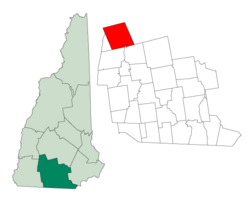Hillsborough, New Hampshire
Hillsborough, New Hampshire | |
|---|---|
Town | |
 Location in Hillsborough County, New Hampshire | |
| Country | United States |
| State | New Hampshire |
| County | Hillsborough County |
| Incorporated | 1772 |
| Government | |
| • Board of Selectmen | Gary Snair, Chairman Laura D. Simoes Robert I. Buker |
| Elevation | 636 ft (194 m) |
| Population (2000) | |
| • Total | 4,828 |
| Time zone | UTC-5 (Eastern) |
| • Summer (DST) | UTC-4 (Eastern) |
| Website | www.town.hillsborough.nh.us |
Hillsborough is a town in Hillsborough County, New Hampshire, USA. The population was 4,928 at the 2000 census. It includes Hillsborough Center, Upper and Lower villages. The town is home to Fox State Forest and part of Low State Forest.
History

The town was first granted in 1735 by Colonial Governor Jonathan Belcher as "Number Seven," one in a line of nine towns set up as defense barriers against Indian attacks. The towns were renamed following the 1741 establishment of New Hampshire as a separate province. Settled in 1741, the town was granted in 1748 by Governor Benning Wentworth as "Hillsborough," named for Sir Wills Hill, Earl of Hillsborough. It would be incorporated in 1772 by Governor John Wentworth.
Hillsborough is the birthplace in 1804 of Franklin Pierce, 14th president of the United States, and the only president from New Hampshire. The Pierce Homestead was built in 1804 by his father, Benjamin Pierce, a general in the Revolutionary War, and twice governor of New Hampshire. Restored in 1925, the home was designated a National Historic Landmark in 1961. Listed on the National Register of Historic Places, the house is today a museum owned by the state, and operated by the Hillsborough Historical Society.

Notable Inhabitants
- Franklin Pierce, 14th President of United States
- John Butler Smith, governor and manufacturer
- Benjamin Pierce Cheney, a founder of American Express
Geography
According to the United States Census Bureau, the town has a total area of 115.6 km² (44.6 mi²). 113.0 km² (43.6 mi²) of it is land and 2.6 km² (1.0 mi²) of it is water, comprising 2.24% of the town. Hillsborough is drained by the Contoocook River, in addition to Beard's and Sand brooks. Part of Franklin Pierce Lake is in the southwest. The highest point in Hillsborough is Thompson Hill (1,768 feet / 539 meters above sea level), in the northern part of town. Hillsborough lies fully within the Merrimack River watershed.[1]
Demographics
This article describes the town of Hillsborough as a whole. Additional demographic detail is available which describes only the central settlement or village within the town, although that detail is included in the aggregate values reported here. See: Hillsborough (CDP), New Hampshire.

As of the census2 of 2000, there were 4,928 people, 1,922 households, and 1,312 families residing in the town. The population density was 43.6/km² (112.9/mi²). There were 2,326 housing units at an average density of 20.6/km² (53.3/mi²). The racial makeup of the town was 97.46% White, 0.18% Black or African American, 0.45% Native American, 0.93% Asian, 0.12% from other races, and 0.85% from two or more races. Hispanic or Latino of any race were 0.53% of the population.
There were 1,922 households out of which 33.7% had children under the age of 18 living with them, 53.9% were married couples living together, 10.0% had a female householder with no husband present, and 31.7% were non-families. 23.8% of all households were made up of individuals and 8.0% had someone living alone who was 65 years of age or older. The average household size was 2.55 and the average family size was 3.02.

In the town the population was spread out with 26.5% under the age of 18, 6.7% from 18 to 24, 30.3% from 25 to 44, 23.7% from 45 to 64, and 12.7% who were 65 years of age or older. The median age was 38 years. For every 100 females there were 95.6 males. For every 100 females age 18 and over, there were 94.4 males.
The median income for a household in the town was $44,500, and the median income for a family was $50,445. Males had a median income of $37,016 versus $24,795 for females. The per capita income for the town was $20,122. About 6.7% of families and 9.8% of the population were below the poverty line, including 12.7% of those under age 18 and 10.1% of those age 65 or over.
Sites of Interest
- D.A.R. Museum Room, in the Community Building
- Franklin Pierce Homestead (1804)
- Kemp's Truck Museum
- Fuller Public Library
References
- ^ Foster, Debra H. (1995). Water Use in New Hampshire: An Activities Guide for Teachers. U.S. Department of the Interior and U.S. Geological Survey.
{{cite book}}: Unknown parameter|coauthors=ignored (|author=suggested) (help)